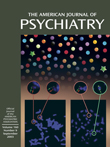Reduced Cortical Folding in Schizophrenia: An MRI Morphometric Study
Abstract
OBJECTIVE: Although well documented, regional brain structural abnormalities in schizophrenia are nonspecific, and morphometric parameters show significant overlapping between patients and healthy comparison subjects. An increasing number of studies have focused on supraregional models involving abnormalities of the neuronal circuitry between cortical regions in schizophrenia. The aim of the present study was to investigate cortical folding as an index of the neuronal wiring in different subtypes of schizophrenia. METHOD: Magnetic resonance imaging measures of gyrification index in intervals of 3.6 mm along the total cerebral cortex were compared in 40 patients with DSM-IV schizophrenia and 20 healthy subjects. Psychopathology was assessed with the Positive and Negative Syndrome Scale, Brief Psychiatric Rating Scale, and the Negative Symptom Rating Scale. RESULTS: The schizophrenia patients showed significantly reduced bilateral cortical folding relative to healthy comparison subjects. Such reductions were more pronounced in those with the disorganized subtype and showed an inverse correlation with negative symptoms and a positive correlation with positive symptoms. The paranoid subtype showed reduced cortical folding that was restricted to the left hemisphere. CONCLUSIONS: These results from a larger patient group confirm a previous report of reduced cortical folding in schizophrenia patients. They also suggest a distinct pattern of abnormality between schizophrenia subtypes regarding the process of cerebral lateralization and are in agreement with the neurodevelopmental hypothesis of schizophrenia.



